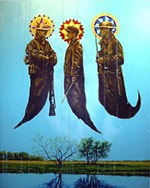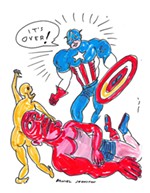'Turner to Monet: Masterpieces From the Walters Art Museum'
These 40 works impressively chart the evolution of art across the 19th century
Reviewed by Robert Faires, Fri., Dec. 17, 2010

'Turner to Monet: Masterpieces From the Walters Art Museum'
Blanton Museum of Art, MLK & Congress, 471-7324
Through Jan. 2
The portrait of William T. Walters that greets visitors to "Turner to Monet: Masterpieces From the Walters Art Museum" is so decidely glum – the mournful basset-hound eyes under weeping willow brows, the snowy walrus mustache drooping below the chin like an outsized furry frown, the hands tightly clasped in front of the long, black topcoat in the manner of an undertaker – as to create the impression that the Baltimore liquor and railroad magnate is none too happy with the art you're about to see. But perhaps his doleful aspect has less to do with the works themselves than with the direction that he saw art taking in the final decades of his life. As the exhibition title indicates, this selection from the vast art holdings that Walters and his son Henry amassed spans the 19th century, a time in which European and American painters moved from the clean edges and naturalistic portrayals of the classical tradition into the indistinct, extravagantly hued experimentations of impressionism. For many, that progression proved unsettling.
See, in the front half of the 1800s, how the past is still present and the rural rules. That's clear in the show's first blockbuster works, Raby Castle, the Seat of the Earl of Darlington, by J.M.W. Turner (1817), and The Catskills, by Asher B. Durand (1859). Both landscapes offer breathtaking vistas that seem to extend into infinity. Turner's massive, swirling clouds sweep across the top half of the canvas like gods at play, dwarfing everything on the rolling hills below: rider, hounds, trees, even the castle itself. Durand lets the trees do the dwarfing: Black birches and sycamores tower over us at the edge of a drop-off into Plaaterkill Clove. This is nature as Nature, majestic and imposing, yet able to be tamed by man, as evident in the westward expansion across North America.
Beyond these works hang more pastoral images, peaceful fields in which sheep and cattle graze and peasants labor. Trees may still tower and clouds glower, as in Jules Dupré's curiously luminous A Bright Day (1835-40) and Jean-François Millet's The Potato Harvest (1855), but neither animal nor human betrays any sign of concern. At the end of the day – literally, in the case of Jules Adolphe Aimé Louis Breton's Returning From the Fields (1871) – all is in harmony with the natural world. In the thick, golden weeds and white-topped green stalks that rise to their shoulders, three barefoot maidens seem to belong.
In the early 19th century, we belong in the natural world and have dominion over it. In the country scenes, the laborers in the field are reaping the crops they have sown, shepherding the livestock they have bred, and in the scenes drawn from the Bible and myths, the figures exert just as much control. The waters may churn in Eugène Delacroix's Christ on the Sea of Galilee (1854), but the sleeping Jesus lies serenely in his disciples' tempest-tossed boat, and in Oedipus and the Sphinx (1864), J.A.D. Ingres has rendered the warrior-hero with a casual confidence, nonchalantly leaning forward, his ample muscles relaxed, as he answers the beast's deadly riddle. This was an era when answers were clear-cut; when perils could be beaten or, at the least, endured; when art idealized us in the way we wanted to see ourselves.
But then, in the back half of the century, things get blurry. The images begin to lose their smooth, romantic clarity; their classical and even bucolic heroism; their sense of order. They may show us in the natural world, as with the maiden placidly reading in Claude Monet's Springtime (1872), but nature itself is reduced to blobs of white paint against smudges of green. The formal compositions of yore go off-kilter, as in Edgar Degas' Before the Race, with its foregrounded jockeys and horses thrown against the left edge of the canvas. And the Edenic countrysides and noble peasants of the field are supplanted by urban kiosks and the demimonde of cafe society. Could that dissolute young woman with the glazed stare in Édouard Manet's At the Café (1879) be a prostitute? Even the subject of Mariano José María Bernardo Fortuny y Marsal's An Ecclesiastic (1874) has a dissipated air to him, especially against that lurid crimson background. Its vibrant colors in almost blockish fields of color seem to anticipate the abstractions of modernism. For us looking back from the 21st century, these are thrilling images to see, but one can imagine a tycoon reared on nature and classicism to be disspirited by this turn toward the urban and abstract.
This collection charts – and impressively so – the passing of his time. And when you reach the end of it, it's almost as if you can turn the corner and see the 20th century.










